#melanistic bengals
Explore tagged Tumblr posts
Text
One year ago today...
Maraly had her kittens! Happy birthday to Ellie, Inkheart, Sabine, Prince and Roxie!

A wee Ellie! (the firstborn)

how tiny is a newborn kitten? well...

VERY tiny 🥹💜🐈⬛

Maraly and her five littles! They're all much bigger than her now! 🥹(also you can see Ellie's spots in this picture!)

Proud mama Maraly. 💜
And some more ~recent~ pictures of the bbys

Ellie! (and Meggie) and yes that's Ellie's paw sticking out- bby got BIG! :D

One of the black babies with their big brother/uncle Gimli. 💜

All three black kittens! Inkheart is in the back, Sabine is front right and Prince is front left! (don't ask me to identify them in any other pictures, I can't, but boy kitty faces look different from girls and I can see Sabine's little white hairs on her chest, those are the only reasons I know xD)
I don't know where my more current pictures of Roxie are, I think maybe my mom has them, but Roxie is also doing great, never doubt it!
Happy birthday my not-so-little littles! 💜🐈⬛🐈⬛🐈⬛🐈⬛🐈⬛
#kittens#bengal kittens#charcoal bengals#cashmere bengals#melanistic bengals#cats#maraly the kitten#maraly the kitten's kittens#madia is crying at me like 'what about me!'#like bby your birthday is next week don't worry xD#they're so big and beautiful I'm so proud of them all <3
4 notes
·
View notes
Text
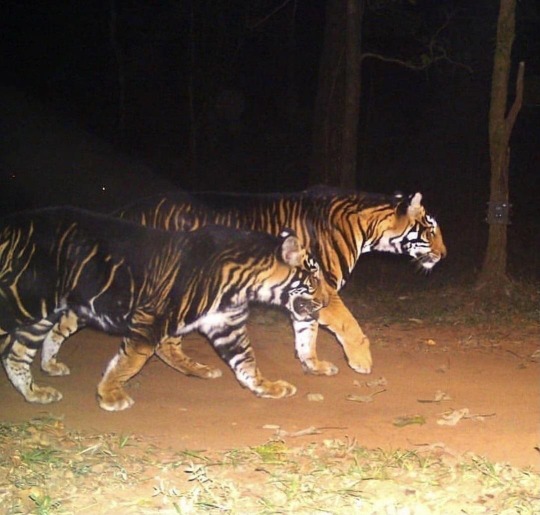
Abundistic Bengal tigers (Panthera tigris tigris)
#abundistic#abundism#pseudo melanistic#pseudo melanism#bengal tiger#tiger#Panthera tigris#Panthera tigris tigris#mammal#color mutation#felid
8K notes
·
View notes
Text
not art but i was thinking abt what cats toothless and the light fury would be and these r what i landed on!!! ^_^ i think they’re sooo silly and these fit them so well,, toothless is a melanistic bengal and the light fury is a white american curl


#httyd#how to train your dragon#light fury#toothless#toothless httyd#the light fury#httyd 3#httyd thw#light fury httyd#melanistic bengal#american curl
69 notes
·
View notes
Note
Eepol u should draw Geno and cat Reaper 🫶
idk if that nickname makes sense on tumblr lmao

anywho have a few doodles
#can you tell i’m a warrior cats artist too lmaoooo#bahah#little guy#this is one of three cat reaper designs i have#one is fully black#and the other is a melanistic bengal :P
10 notes
·
View notes
Text
This baby looks just like my cat Diamond did at that age! Diamond was a melanistic Bengal, and like black leopards/panthers they are black with black spots. This little baby's spots likely disappeared as it got older and darker- but the spots are still there! You just can only see them in the right light. Very beautiful little baby!
(If you're curious, the difference between melanistic Bengal cats and charcoal Bengal cats- which are what my babies are- it's that charcoals have white "glasses" or a "Zorro" mask around their eyes and a black "cape" along their backs that melanistics don't have. But! a Bengal cat MUST have a melanistic gene to make a charcoal kitten, so they're very closely related! Maraly did have three melanistic kittens and they are all very beautiful.)
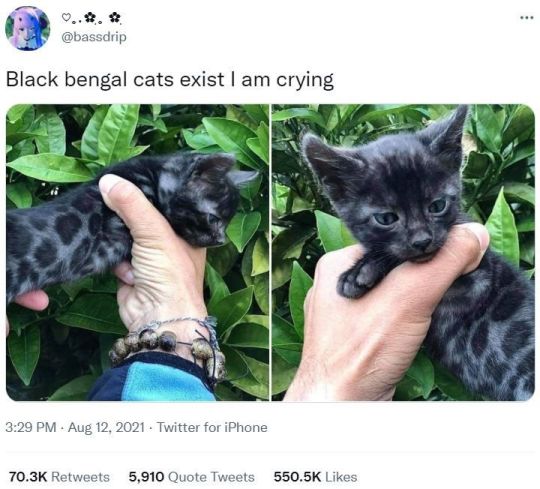
#bengals#cats#kittens#this has been your entirely unsolicited brief explanation of bengal cat genetics#and the difference between charcoals and melanistics#tune in next time for more random rambles#thanks for the tag!
21K notes
·
View notes
Text
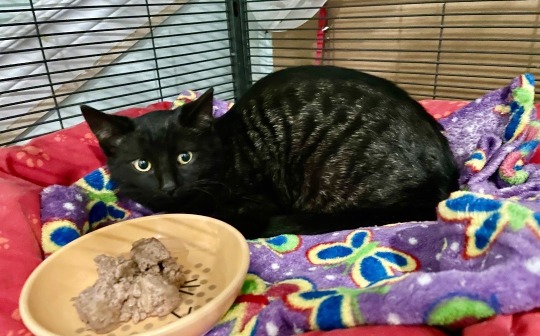
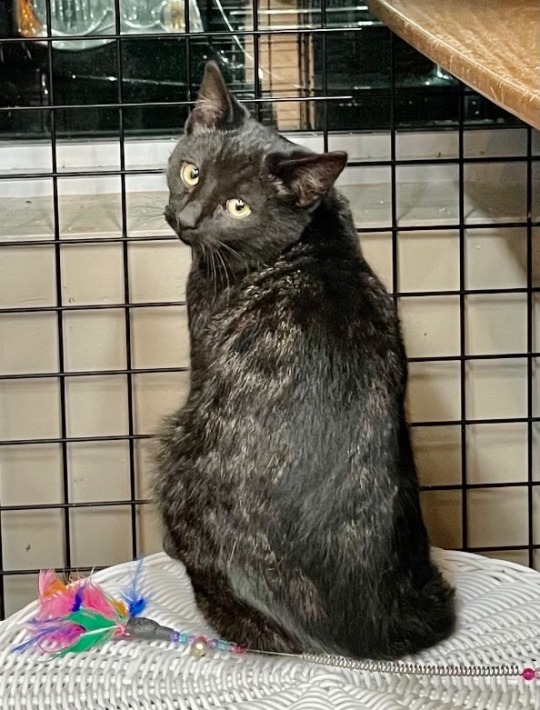

I was looking at local shelter cats, and this guy's colouration is bizarre.
it reminds me of the charcoal gene that bengals have, but without the distinctive white goggles:
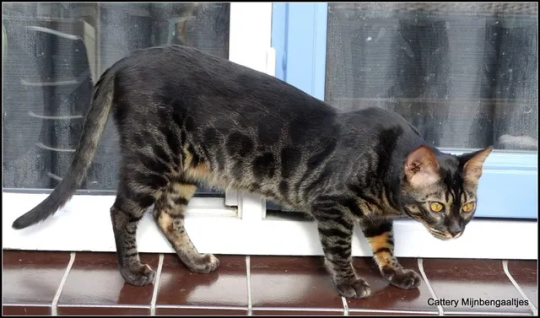
or the melanistic mutation you see in leopards:

he's up for adoption in Ontario, if you want to bring home a mutant!
6K notes
·
View notes
Text
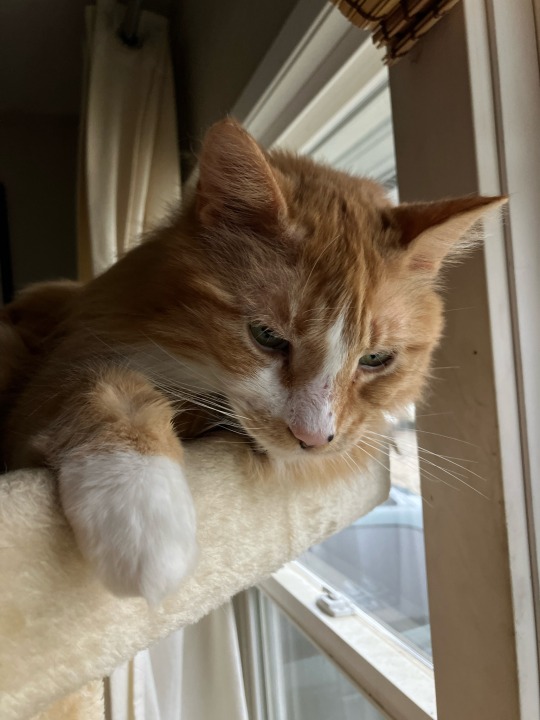
Despite being still fairly feral at thirteen years strong, my boy Casper the orange tabby floof displays multiple traits of domestication: bold white markings, long exquisitely soft hair, and an orange coat which would only ever rarely ever occur in the wild. Also, allergies.
There Was Another Domestic Cat!
I hate that I'm only now in 2024 learning about this rad 2016 cat science find (frustrating that it wasn't more publicized,); there's evidence in China that there was once a second species of domestic cat, Prionailurus bengalensis, or the Asian Leopard Cat. Fellow cat nerds will recognize that this is the same wild species that was hybridized with the domestic cat to produce the famously active and beautiful breed known as the bengal cat, however these ancient domestic cats evidenced in the study share no relation to the modern bengal. Modern domestic cats notably descend from the African wildcat (Felis silvestris lybica.)
The evidence of the domesticated version of the Asian Leopard cat is primarily wear patterns on teeth still connected to jaw bones found in China which do not show up in fully wild kitties. This basically means that these domestic cats were eating a diet which their wild brethren do not consume.
To me, the idea of a second ancient species of domestic cat is extremely intriguing and I will most definitely need to draw a concept if what these cats would have looked like with the calling card bold white markings and other domestic traits which inevitably appear in domesticated animals, as shown in the Russian Silver Fox Project which eventually produced completely domesticated foxes. It would also be very interesting scientifically to see the full ancient domestication of the Asian Leopard Cat reproduced although with thousands of modern domestic kitties in need of homes this experiment is likely never going to happen (which is for the better with so many far more suitable modern purr machines available for adoption.)
Domestication of modern domestic cats (Felis silvestris catus/Felis catus) likely took place on the Mediterranean island of Cyprus some 10,800 years ago with the cats quickly spreading to Egypt and China where they became beloved fixtures of temples, homes and palaces. Today thanks to artificial selection these kitties exist in miriad beautiful breeds and coat patterns but more importantly, modern kitties are noble, affectionate, and extremely social companions of the educated, responsible human household.

My three year old blue tuxedo cat Keplar, who spends his days playing, following me around everywhere that he can (getting very frustrated when he cannot,) chatting with me, and snuggling with his thirteen year old unrelated fluffy orange tabby brother, Casper. With a dilute gene turningwhat would've been a melanistic coat grey and bold white markings which are found only in domesticated animals, Keplar is an excellent representative of the modern domestic cat.
#cats#cats of tumblr#kitties#domestic cat#house cat#cat#cat news#cat science#asian leopard cat#bengal cat#african wildcat#archaeology#Chinese archaeology#Prionailurus bengalensis#Felis silvestris lybica
22 notes
·
View notes
Text

my anthro dib. I literally never draw him but here they are .
he is a melanistic bengal cat if anyone is curious . I specifically chose a bengal bc 1. They r kool af. N 2. They have a few dog like traits and dib is very dogcat creature to me <3
6 notes
·
View notes
Text

or you could have. multiple gargoyles.
I'm not planning on getting a cat, but if I did get a cat I'd probably name it Gargoyle
#I recommend: melanistic bengal (pictured)#they have hidden spots and become VERY dark black as they age#I just wanted to show off my now-grown bbys#maraly's trio of black kittens deserves the love
95 notes
·
View notes
Text
Blackwidow is a melanistic bengal cat btw
Firestorm is like a mix of a Maine Coon and a Toyger
And Emberstrike is closest to a Tabby, but without stripes
Of course they aren't domestic cats, these are just the breeds they are based on/ most similar to



#fnf au#fnf#pico newgrounds#fnf pico#warrior cats#darnell newgrounds#fnf darnell#nene newgrounds#fnf nene#erin hunter warriors#hurray for silly cats#images are not mine#they come fron google lol
3 notes
·
View notes
Text
Kitten update!
So Maraly's kittens are now four weeks (1 month) old and Leeli's are now 3 weeks old! And you know what that means...
NAMES! :D
I know some of you wanted me to give them Wingfeather names to go with the mamas, but the problem with that is... we can't keep 11 kittens. Even I, who am the epitome of a crazy cat lady with the softest heart for kittens ever, know that this is not feasible. We already had four cats before this, and we're keeping the three original rescues. We can't have 18 cats again, especially if 16 are inside our house! And it's going to be very hard for me to give the babies up as it is and giving them names of characters (or other cats I've had) I love will just make this harder. Also, my mom came home one day like, "so I think we should name the kittens after Inkheart characters" and who am I to disagree I love the Inkheart series. That being said there is one special baby kitten with a Wingfeather name but I'll get to her later.
Maraly's babies names!

So this is Elinor (Ellie), formerly known as Gray! She is the eldest kitten, Maraly's firstborn, and she acts like it! She is the biggest and most advanced in skills. My mom said the other day (and I agree) that she acts more like a 6 week old than a 4 week old (and she weighs 1.2 pounds! That's about a FOURTH of Maraly's body weight!). She leads the charge in most accomplishments (except eating, interestingly enough, she was the third to start eating wet food) being able to run, hop, climb, play with balls, use the litterbox and attempt to escape their playpen before all the rest of her siblings! And she is the SWEETEST little darling- loves to cuddle and looks at you with the most adoring eyes. We don't know who she's meant to help, but she is an awfully special kitten and God definitely has a plan for her.
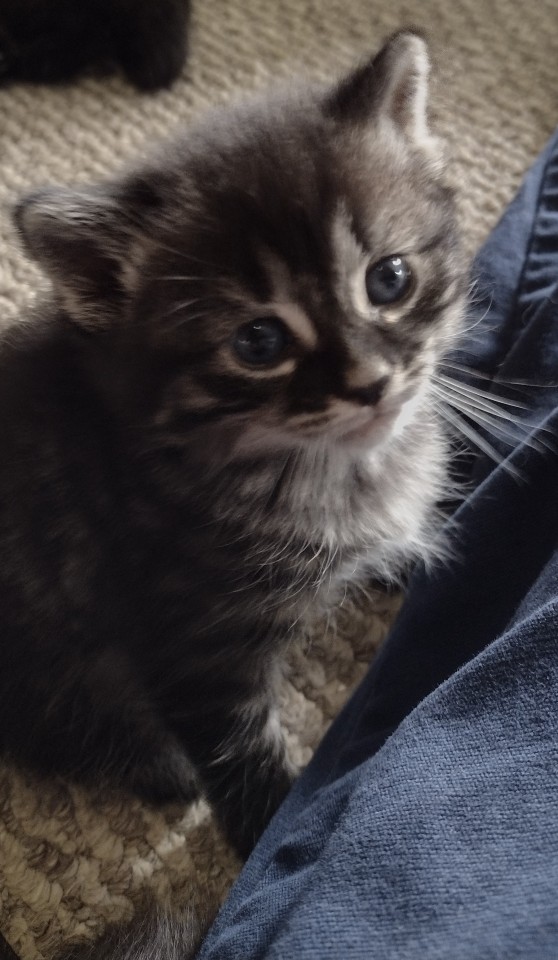
This is Roxanne (Roxie), formerly known as Four as she was the fourth of Maraly's kittens born. She is right behind her sister Ellie in all physical accomplishments, though she was the last kitten to start eating wet food (I JUST got her to start YESTERDAY!). She is a BUSY little thing, always running and adventuring somewhere! She wants to go everywhere and see everything. She's also very sweet, though less cuddly and she likes to try and climb my legs. xD
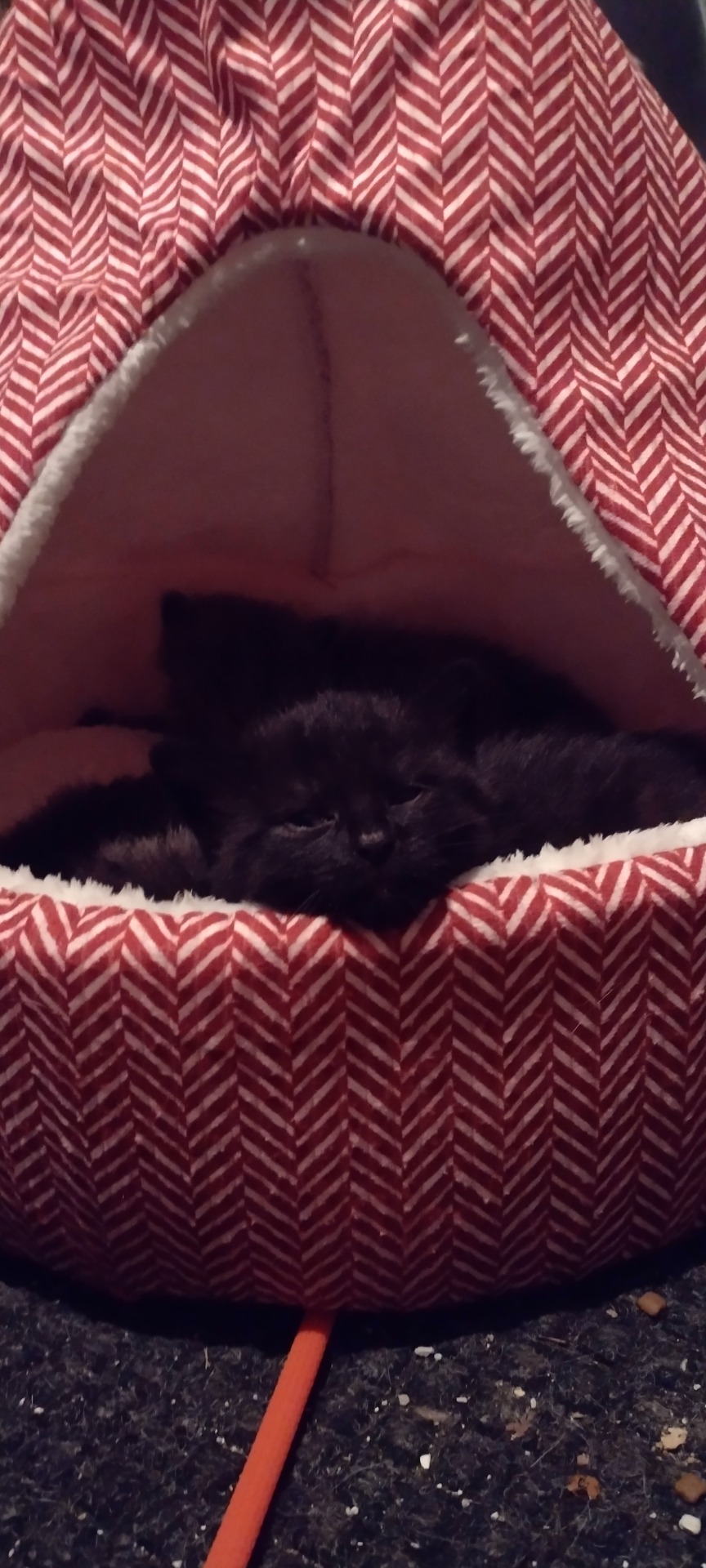
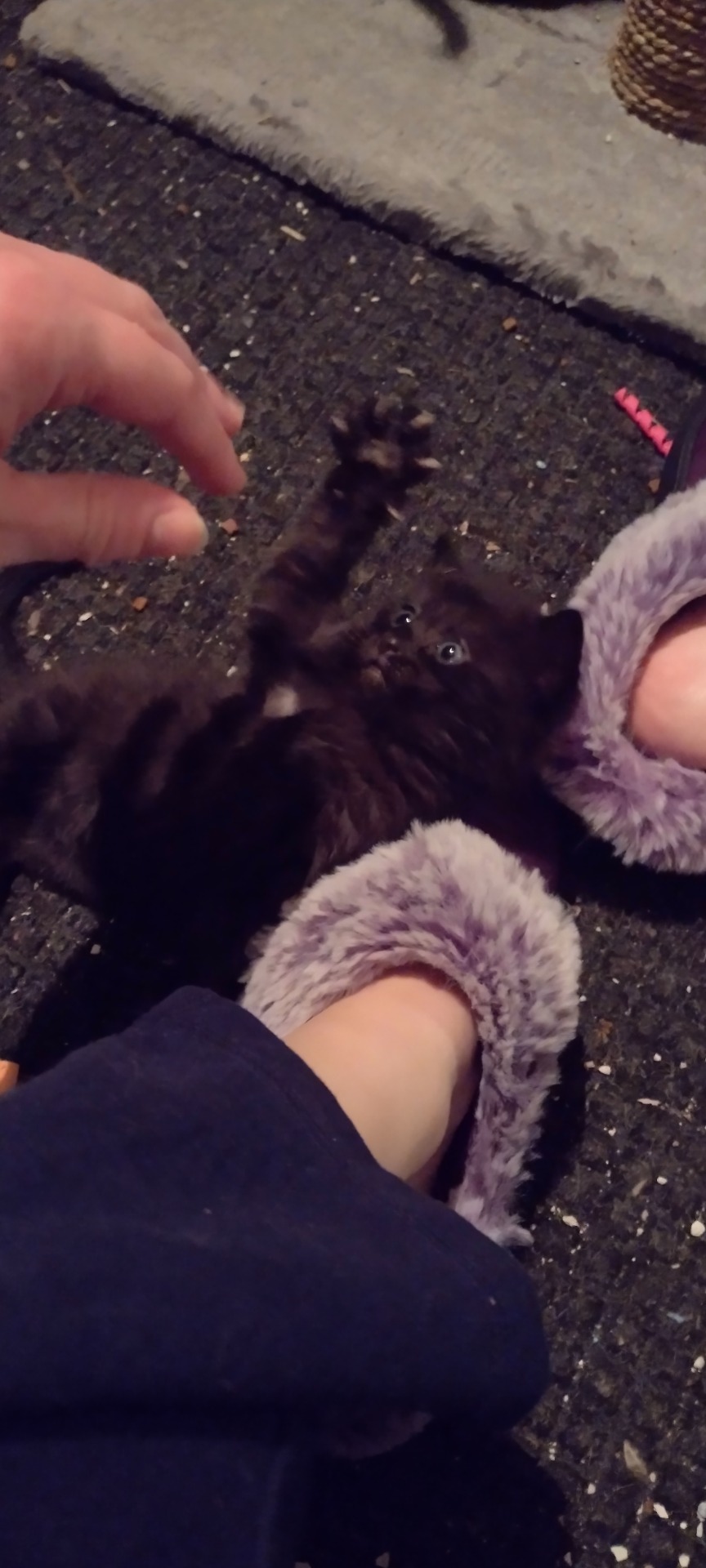
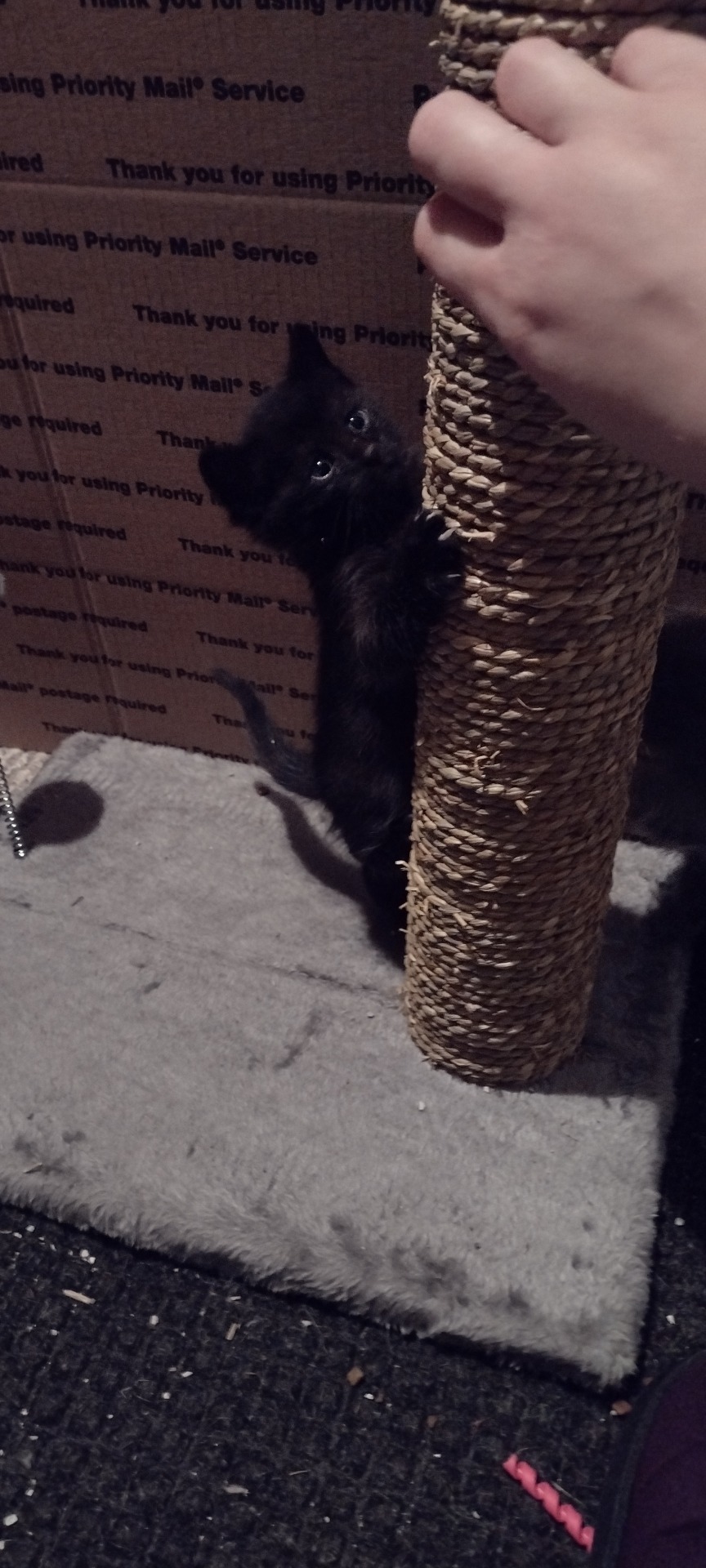
Maraly's three black babies are nigh impossible to distinguish in pictures so here's just some cute pictures of the three of them.
The biggest black kitten's name is Inkheart, as she is black and easiest to see markings on in the right light (since Inkheart is the name of a book markings=words, I thought it was fun and my mom insisted we name a kitten Inkheart so xD). She was the first to start eating solid food (wet AND dry food!). She screamed a LOT at me when she was younger but now she likes to climb on my lap and cuddle (or bite me, y'know, depends on the mood xD).
The second biggest kitten is named Sabine, formerly known as white spot. My dad named this one after a character in the Star Wars show Rebels since we've been watching it and we all think she's cool. She was the second kitten to start eating wet food and she ALSO likes to climb on my lap and attack and/or cuddle with me. xD
The littlest black kitten is Maraly's one and only boy, named The Black Prince (Prince) and formerly known as white tip, since he has a few white hairs on the very tip of his tail and it's how I've been distinguishing him since he was a newborn. xD He's an awfully cute little bugger, and fiesty, very playful.
All three of Maraly's black babies frequently play together and get up to trouble together. For instance, today they were trying to climb on top of their play tent WHILE their baby cousins were sleeping in it! They also often gang up on Maraly to nurse from her. xD Two of them (Prince and Sabine, I think) have been claimed by a girl who works at a local bakery my mom often stops at, so they will be able to continue to cause trouble together even after they leave us!
Since tumblr only lets me put ten pictures in a post and this is already quite long I'm going to put the names of Leeli's babies in another post (hopefully soon). In the meantime, here's a few more pictures:
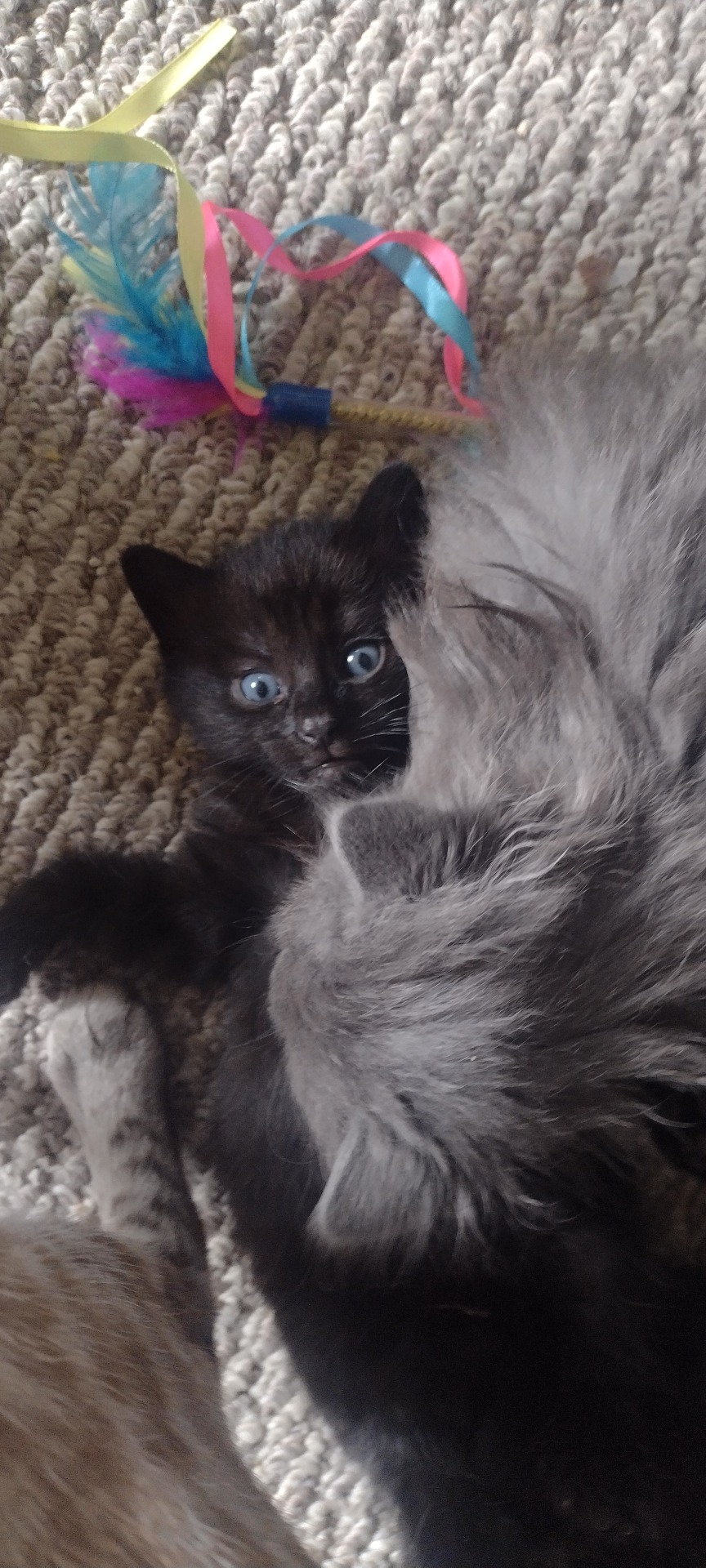
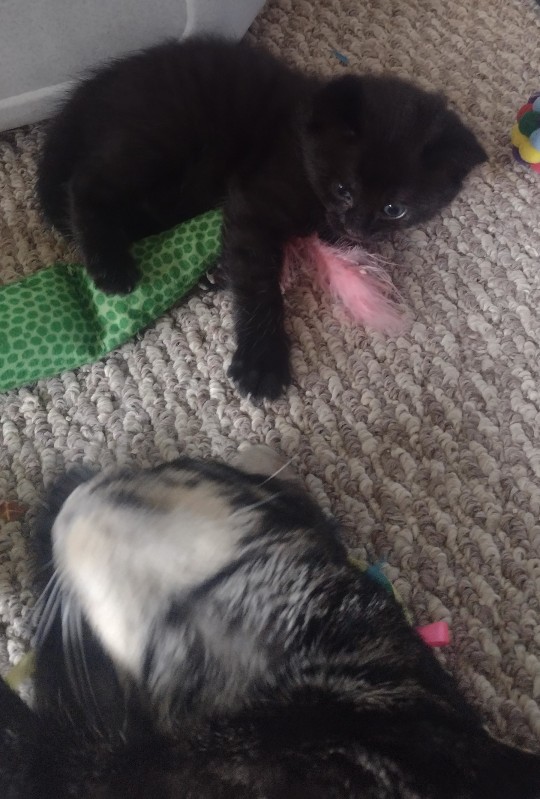

*I'll make a man out of you playing in the background*

Meeting uncle Kalmar! (he was so sweet and nice to her! didn't hiss or growl and I think he gave her a kiss here <3)

This kitten is illegally cute *flips table*
#kittens#bengal kittens#maraly the kitten's kittens#maraly the kitten#elinor the kitten#roxie the kitten#sabine the kitten#prince the kitten#inkheart the kitten#inkheart#star wars rebels#charcoal bengals#melanistic bengals#cashmere bengals#ellie is a cashmere bengal I'll die on this hill#she may not have the bengal look but she has the bengal SPIRIT#maraly's genes are STRONG with her babies#they're so ADVANCED for being just a month old ;-;#and so BIG#I have to post some pictures of the litters together because maraly's are at least twice the size of leeli's#except ellie she's 3 times their size xD
11 notes
·
View notes
Note
Personally one of the things that confuses me the most about bengals is how solid/'melanistic' snows still have super well defined tabby patterns show up on the body with just, solid points. I have not seen any non-bengal cats with colour restriction do that, it's so bizarre.
Yeah, it's bit like with the smoke egyptian mau: these breeds were both selected for as contrasting patterns as possible, and the "contrast polygenes" will do their work on solids too, and bring out the ghost pattern. If you want strong pattern on tabbies, you'll get strong ghost patterns on solids as well.
The melanistic snows' markings probably show up more on the body than the points because of the relative difference in pigment density is much higher there.
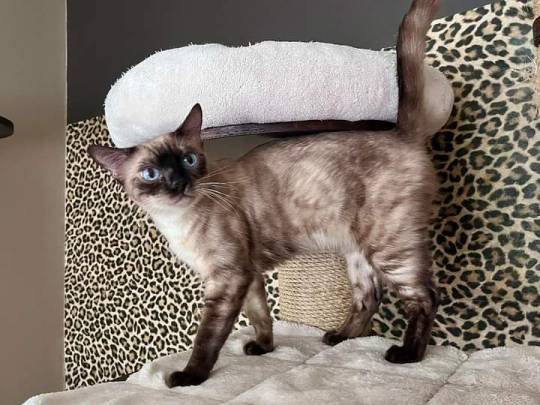
A nice black smoke point bengal with visible pattern: Yagobengals Havanna MoonShine (smoke is a very tricky thing with points, hard to spot)


Tabby point (snow lynx) and regular tabby cats from the same cattery for comparison.
#it's like you're saying 'let there be more difference between the agouti bands!'#and the agouti band will obey regardless the color#bengals#ask and answer#ghost pattern#cats#color restriction#agouti
20 notes
·
View notes
Text
Learning new cat colour genetics. Hybrid introduced genes.
Basically, I learnt most of the genetics of cats and some rodents from a book called the Colour Inheritance in Small Livestock by Roy Robinson. Printed 2013.
But new genes have been discovered since, part 4.


Bengal (Asian leopard cat, ALC)-
Come in Spotted and marbled. Ocelli refers to white spots on back of ears f1-f3.
Brown- normal, but can be chocolate (choc not black markings) and golden (with Inhibitor gene)
Snow bengals- Seal lynx point (tabby point) (cs cs), seal mink (cb,cs), seal sepia (cb,cb). Eyes are blue, aqua and green or gold I'm that order.
Silver bengals- inhibitor gene, ground is white to steel grey. Markings dark grey to jet black.
Charcoal- modification of tabby gene, occur as Alc asip mismatches with domestic asip gene. So come in charcoal brown, charcoal snow and charcoal silver. Barely any rufousing, black markings. "Zoro" Mask on nose and face.
Sorrel- lighter shades of brown, similar to cinnamon. Is corin gene
Wheaten- non rufous sorrel
Whited- white fronts, face and undersides. From Asian leopard cat. Not linked to white spotting.
Melanistic- black self
Blue- ground pale blue grey to slate blue grey. Markings are medium to dark blue. Not recognised in bengals.
Albino- white with red/purple eyes. Pink paw pads. May have come from Asian leopard cat
Glitter- Fgfr2 mutation in domestic cats. Soft and iridescent fur. Caused by hollow spaces in hairs. Two versions. Mica looks like tiny "silicate crystals" in the hair tips. Recessive. Not on solid cats
Satin- Is whole hair shaft and have larger air cells in hairs. Causes translucency. Recessive.
Patina - dark hairs blur the basic black/ brown pattern on the back/shoulder. Causing it to look fading
Cashmere/Pardino- long haired bengal

Savannah- (serval)-
Bengal colours
Servaline- a tabby that has small freckle spots. Instead of big spots


Chausie- (jungle cat)-
Grizzle- silver tipped black. Type of glitter. From Jungle cats
Geoffery cat and oncilla hybrids had fertility issues. Margay Hybrid resemble bengal.
#cat genetics#bengal#snow bengal#seal lynx#seal mink#seal sepia#charcoal#silver#brown#glitter#servaline#grizzle#sorrel#wheaten#hybrid colours
6 notes
·
View notes
Text


The melanistic bengal im trying to buy 😭
18 notes
·
View notes
Text
Poaching of rare melanistic Royal Bengal Tiger at Similipal: Armed policemen to guard tiger reserve
Armed police forces are being deployed to assist forest personnel in patrolling poaching-prone areas of Similipal Tiger Reserve (STR) spread over Mayurbhanj and Balasore districts in Odisha, officials said on Thursday. The decision was taken after the state forest department suspected that a melanistic Royal Bengal Tiger was killed in November last year in the STR, the world’s only habitat, where…
0 notes
Text
Melanistic Tiger Safari
Odisha is set to unveil the world's first melanistic tiger safari near the Similipal Tiger Reserve (STR). Odisha's Vision for the Melanistic Tiger Safari - Melanism and Melanistic Tiger: Melanism is a genetic condition, that results in increased melanin production, leading to black or nearly black skin, feathers, or hair in animals. - The Royal Bengal Tigers of Similipal boast a distinctive lineage with elevated melanin levels, giving rise to black and yellow interspersed stripes, making them pseudo-melanistic. - According to the All India Tiger Estimation, 2022, Similipal Tiger Reserve houses 16 tigers, with 10 of them displaying melanistic traits. - Location of Safari: Spanning approximately 200 hectares near Dhanbad-Balasore National Highway-18, the safari site lies in close proximity to STR, providing a landscape akin to Simlipal. - In the beginning, three melanistic tigers from Nandankanan Zoo, along with rescued or orphaned tigers, will occupy the open enclosures of the safari. - Objective: It aims to raise awareness about the conservation needs of melanistic tigers, providing a platform for researchers and enthusiasts to engage with these rare big cats. - Approval: The project necessitates approvals from the Central Zoo Authority and other regulatory bodies overseeing wildlife initiatives in the country. - A National Tiger Conservation Authority committee will also conduct a feasibility study of the proposed site before granting final clearance. Other Colour Variations in Tigers - Orange with Black or Brown Stripes: This is the most common and widely recognized tiger coloration, e.g, the Royal Bengal Tiger.Each tiger's stripe pattern is unique, serving as a form of camouflage, in their natural habitat. - White Tigers: They are not considered a separate subspecies. The colour of the white tiger's fur is the result of a genetic mutation called leucism.Leucism is a genetic condition that results in reduced pigmentation in animals, causing them to have white or pale-colored skin, feathers, fur, or scales. - Golden Tigers: They are also not considered a subspecies of tigers because their golden colour variation is caused by the presence of a recessive gene called "wideband".The wideband gene reduces melanin production during the cycle of hair growth.Recently, it was spotted in Kaziranga National Park. Similipal Tiger Reserve - Location: Similipal is situated in the Deccan Peninsula Biogeographic Zone. - Vegetation: Predominantly moist mixed deciduous forest with tropical semi-evergreen patches and sporadic dry deciduous forests and grasslands. - Floral Richness: Holds 7% of India's flowering plants and 8% of its orchid species. - Faunal Diversity: Home to 55 mammal species, 361 bird species, 62 reptile species, 21 amphibian species, and numerous insects and microfauna. - Major species other than tigers include sambar, chital, barking deer, gaur, and mouse deer, leopards, fishing cat etc. - Management efforts have revived mugger crocodile populations along rivers Khairi and Deo. - It has also been designated as a Global Network of Biospheres site since 2009. Read the full article
0 notes